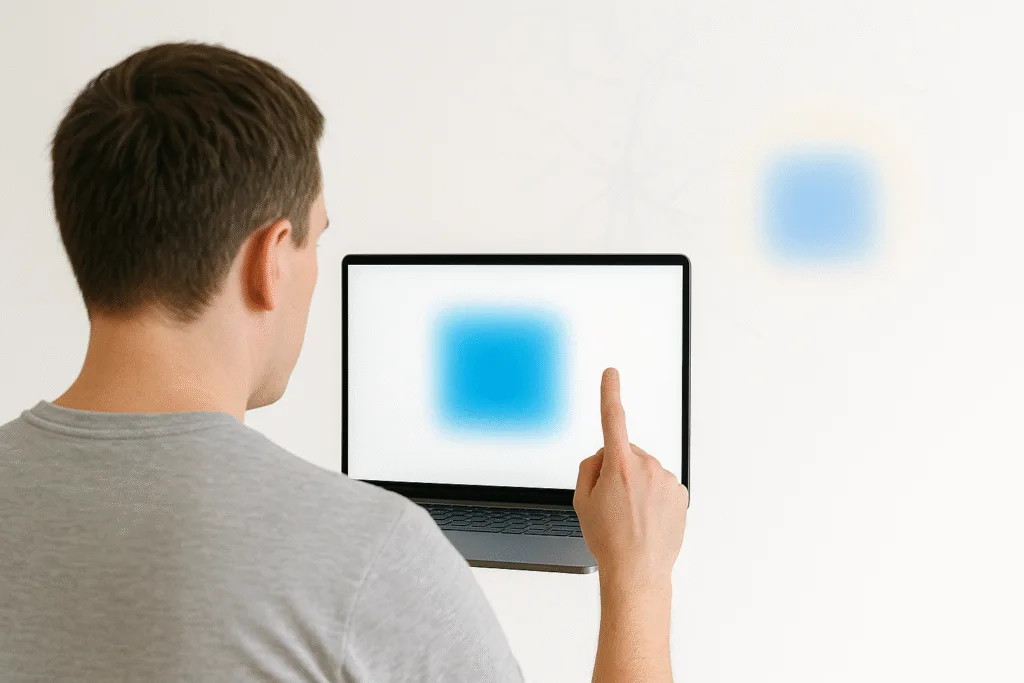The afterimage illusion test is one of the simplest and most surprising demonstrations of how your brain manipulates color, light and perception in real time. In this experiment, you will stare at a colored image, turn your eyes to a blank surface, and suddenly see colors that are not actually present.
This illusion happens because your brain continues projecting information even after the visual stimulus disappears. It is one of the clearest examples of how vision is not created by the eyes, but by the brain itself.
Let’s begin the afterimage illusion test.
Step 1 — Choose a High-Contrast Colored Shape
You will need a bright, solid shape such as:
- a red dot
- a green square
- a blue circle
- a yellow triangle
Any distinct color works.
Place the shape on your screen or hold it on paper.
Why this matters
The afterimage illusion test depends on strong visual saturation.
The more intense the color, the stronger the afterimage your brain will create.
Step 2 — Stare at the Center of the Shape for 20 Seconds
Fix your eyes directly on the center of the colored shape.
Do not look away.
Do not blink excessively.
Keep your gaze steady.
What’s happening now
Your eye’s photoreceptors are:
- overstimulated
- fatigued
- desensitized
- adapting to the brightness
This overstimulation sets the stage for the afterimage illusion test.
Step 3 — Quickly Shift Your Eyes to a White or Blank Surface
After 20 seconds, immediately look at:
- a blank wall
- a white screen
- a sheet of paper
Do not refocus your eyes yet.
Just hold your gaze still.
What you should see
A ghostly image will appear:
- the same shape
- but in the opposite color
- floating in your vision
- even though nothing is there
This is the afterimage illusion.
Step 4 — Observe the Shape and Color Change
The afterimage might:
- become clearer
- fade slowly
- change color
- shift in brightness
- move slightly
Why this happens
Your photoreceptors recover at different speeds.
Meanwhile, your brain fills the visual gap with inverted color information.
This is the core of the afterimage illusion test.
Step 5 — Try With a Different Color and Compare Results
Repeat the test using:
- red → cyan afterimage
- green → magenta afterimage
- blue → yellow afterimage
- yellow → blue afterimage
What this reveals
Afterimages always appear in the opponent color, following the opponent-process theory of vision.
This proves that the illusion is happening inside your brain, not your eyes.

Step 6 — Try Staring Longer for a Stronger Effect
Now extend the staring time to:
- 25 seconds
- or 30 seconds
What changes
The afterimage becomes:
- sharper
- brighter
- more stable
- longer-lasting
Your photoreceptors become more fatigued, making the illusion stronger.
Step 7 — Try the Moving Afterimage Illusion
Stare at the colored shape again.
Then, when the afterimage appears:
- move your eyes left
- move your eyes right
- look up
- look down
What happens
The afterimage moves with your eyes.
This proves that the image is stored in the brain, not in the environment.
Step 8 — Try the “Shape Swap” Variation
Now use a different shape:
- a triangle
- a letter
- a symbol
- a geometric pattern
Run the test again.
Why this matters
Your brain creates the afterimage based on structure, not just color.
The illusion adapts to the complexity of the shape.
Step 9 — Test the Illusion With Eyes Closed
Stare at the colored shape for 20–30 seconds.
Then close your eyes gently.
What you’ll see
The afterimage appears:
- dimmer
- softer
- floating in darkness
- still in the opponent color
This proves that the afterimage exists independently of external light.
Step 10 — What This Brain–Body Glitch Reveals About You
The afterimage illusion test teaches important facts about your visual system:
1. Your brain creates most of what you see
Vision is a reconstruction, not a raw image.
2. Photoreceptors fatigue and recover at different speeds
This creates inverted color responses.
3. Your brain hates visual gaps
When information is missing, it fills the space automatically.
4. You don’t see with your eyes — you see with your brain
Your brain interprets, corrects, enhances and fabricates vision.
5. The illusion exposes prediction mechanisms
Your vision is constantly adjusted to stay balanced and stable.
The afterimage illusion test shows that perception is not passive.
It is active, dynamic, and deeply influenced by your brain.
Try the Next Brain–Body Glitch Experiment
If the afterimage illusion test revealed how your brain constructs color, the next experiment shows how your brain edits sound in real time. You will experience how your voice changes inside your own head and why it never matches recordings.
Next recommended experiment:
The “Why Your Voice Sounds Different to You” Illusion — Hear Your Real Voice vs Your Brain’s Version
